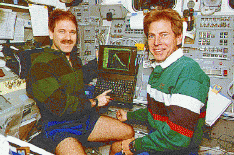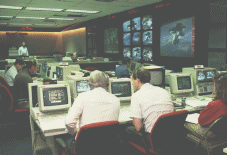|
|||||||||||||||||||
|
|
|||||||||||||||||||
|
|


ASTRO MISSION OPERATIONS
The Astro Observatory was operated directly by the astronauts from the AFT flight deck (see the photo on the left) of the shuttle or in combination with controllers on the ground in the Payload Operations Control Center (photo on the right) at NASA Marshall Space Flight Center. The observatory operates as an attached payload, with the shuttle and Spacelab systems providing power, pointing, and telemetry. The nominal mission plan called for a roughly 24 hour checkout period followed immediately by science operations for the duration of a mission. Although various shuttle tests and other activities (such as waste water dumps) are required, everything possible is done to maximize the time spent using the telescopes.
The three ultraviolet instruments are mounted on the Spacelab Instrument Pointing System (IPS), a Spacelab component developed for NASA by the European Space Agency and used both for the Astro missions and on the Spacelab-2 mission in 1985. The IPS provides a stable platform, keeps the telecopes aligned, and provides various pointing and tracking capabilities to the telescopes. During Astro-1 the IPS had some difficulties locking onto guide stars properly, although an alternate technique allowed the astronauts to manually point the IPS and track targets on the HUT TV camera using a hand paddle (much the same way this is done with ground-based telescopes that do not have fancy auto-guiders). In general, the astronauts were able to provide pointing stability of about 2 - 3 arcsec or better. During Astro-2, several new operational modes were used to achieve "optical hold", and the IPS achieved sub-arcsecond stability. Much work was done by a special task team put together by the mission management team at NASA Marshall Space Flight Center to ensure that the IPS worked properly for Astro-2.
The ultraviolet telescope assembly rests on two Spacelab pallets in the shuttle's payload bay, where it rides into an orbit some 350 kilometers (190 nautical miles) high and inclined 28.5 degrees to Earth's equator. Night launches were used on both Astro missions, which oriented the orbit so that orbital passes through the high particle background part of the orbit (the so-called South Atlantic Anomaly, or SAA) occurred mainly on the daylit side. High energy particles can affect instrument operation and increase the background levels in electronic detectors. Since the "natural" background (that is, scattered light and ultraviolet atmospheric airglow emissions) is also higher on the daylit side, this preserves the orbital night passes for observations of the faintest (and often highest priority) astronomical targets.
Once in space, the aligned UV telescopes were pointed by using a combination of shuttle maneuvers and slews (motions) of the IPS. In addition to tracking guide stars, the system utilized a complex Image Motion Compensation System (IMCS) to eliminate jitter during observations caused by crew motions and thruster firings. This is particularly important for UIT to maintain the quality of its imagery (since the images are recorded on film). The 7-person crew divides up to work 12-hour shifts, keeping the observatory operating constantly while in orbit. Roughly 30 pointings are accomplished on a typical day of science operations.
The Astro-1 mission in 1990 marked the first use of the new Payload Operations and Control Center (POCC) at NASA's Marshall Space Flight Center in Huntsville, AL. Since that time, numerous other Spacelab and related payloads have been operated from this facility. (Shuttle operations, however, are still accomplished from Johnson Space Center in Houston.) Interestingly, Astro-2 was one of the last Spacelab missions to be operated from the POCC as Spacelab missions ramp down in preparation for the Space Station era.
Science and engineering data from the observatory were sent to the ground in real time whenever the shuttle was in direct contact with a TDRS communications satellite. At other times, this information was recorded on-board for downlink later. Scientists and engineers from the ultraviolet instrument teams were able to inspect the incoming science and/or engineering data and troubleshoot any problems that occurred. They could then uplink any necessary changes to the observing plan or instrument operating configurations. (UIT images were recorded on film that could only be developed after the shuttle landed.) Eventually, all of the data arrived at NASA Marshall Space Flight Center where they were archived, processed, transferred onto computer tape or CD-ROM, processed, and supplied to investigators. Only then could detailed calibration, reduction, and analysis of the scientific data take place.
|
|
|




 Follow Us
Follow Us